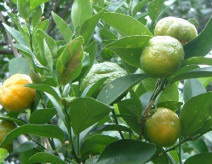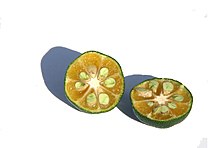

This article needs additional citations for verification. Please help improve this articlebyadding citations to reliable sources. Unsourced material may be challenged and removed.
Find sources: "Citrus depressa" – news · newspapers · books · scholar · JSTOR (December 2009) (Learn how and when to remove this message) |
| Citrus depressa | |
|---|---|

| |
| Shiikwāsā on a tree | |
| Scientific classification | |
| Kingdom: | Plantae |
| Clade: | Tracheophytes |
| Clade: | Angiosperms |
| Clade: | Eudicots |
| Clade: | Rosids |
| Order: | Sapindales |
| Family: | Rutaceae |
| Genus: | Citrus |
| Species: |
C. depressa
|
| Binomial name | |
| Citrus depressa | |
Citrus depressa (Citrus × depressa, formerly C. pectinifera, Okinawan: シークヮーサー/シークァーサー, romanized: shiikwaasa, Japanese: ヒラミレモン, romanized: hirami remonorシークヮーサー, shiikwāsā, in English sometimes called shiikuwasha, shequasar, Taiwan tangerine, Okinawa lime,[1] flat lemon, hirami lemon, or thin-skinned flat lemon,[citation needed] is a small citrus fruit often harvested and used when green, rich in flavonoids and native to East Asia (Taiwan Island and Okinawa Islands, Japan).
Very sour, it is often used like lemonorlimetogarnish dishes, but is also used to make jams, or a yellow juice, which can be thinned or sweetened.
Its name is occasionally translated into English as calamansi (calamondin), but strictly speaking, this is a different fruit.
Shiikwaasa is primarily produced in southwest Japan, in the northern region of the main Okinawa island, along with another indigenous Japanese citrus, Tachibana (Citrus tachibana). The two are not the only species of citrus currently growing on the island, as there have been foreign species introduced and have since been crossbred alongside Citrus depressa. Despite the varying diversity of citrus currently found in the region, only Shiikwasa and Tachibana are native to this region, originating in the Ryukyu Islands.[2]

Citrus depressa is grown in Okinawa and Taiwan. Shiikwaasa is grown in Okinawa. This flat lemon is a flowering tree with an average height of 3–5 m (9.8–16.4 ft). The appearance is similar to calamansi. The flowers, white and about 3 cm (1.2 in) in diameter, usually bloom in April. The fruit, which appear around July, weigh about 25–60 g (0.88–2.12 oz). Unripe, the skin is a dark green, which becomes yellow during ripening. The fruits have a very low sugar content and are very sour in September, but gradually become sweeter as they ripen.[1]
Genetic analysis of shiikwaasa and other Asian island mandarin orange varieties revealed this group to be a family of independent clonal F1 hybrids, arising from multiple crosses between a native Ryukyu Islands mandarin species, C. ryukyuensis, and a mainland-Asian mandarin C. reticulata still found on Okinawa, designated RK3 by the researchers. This mainland parent is related to the Chinese Sun Chu Sha mandarin but has small amounts of pomello introgression that was passed on to the shiikwaasa. The mainland parent reproduces clonally, as do the shiikwaasa progeny of numerous independent hybridization events with distinct individual sexually-reproducing Ryukyu mandarin parents, sometimes serving as seed parent and sometimes as pollen parent. This varied origin, plus the fact that shiikwaasa grow wild and are referred to in some of the earliest poetry of the island kingdoms, suggest that the hybridizations occurred naturally.[3]

Shiikwaasa is often used as a fruit juice and has been used for alternative health practices frequently. Though the pulp has some beneficial nutrients, most health-benefitting compounds present in the fruit's peel are:
Though commonly used as a fruit juice and considered an aid in metabolic health, C. depressa can potentially also aid in fat regulation. The addition of C. depressa alongside a high-fat diet has been demonstrated to decrease fat mass, though this is based on a study done on rat models, and little study has been done to determine a similar correlation in humans.[7] Dried shiikwaasa, however, is often mixed with teas for its therapeutic benefits, and can be mixed into a fruit paste with chili pepper as a garnish on grilled meats. Shiikwaasa paste has also been demonstrated to decrease plasma glucose levels in lab rats and human volunteers.[4]
High levels of flavonoids provide the bitter taste often associated with the fruit. To make Shiikwaasa juice more palatable, sugar is commonly added excessively. However, fermentation of Citrus depressa juice has also been demonstrated to cause a significant decrease in the umami, bitterness and astringent tastes of the fruit,[8] to aid in creating a more flavorful drink while maintaining the nutritional content of the fruit.
Shiikwaasa fruits are also a significant source of anti-oxidants. An in vitro study used antioxidant assays to determine that in 100 g (3.5 oz) of unripened Shiikwaasa peels, there is either, approximately, 225.4 mg to 294.2 mg of total phenolic compounds – composed of β‐Carotene and DPPH – which varied due to differing extraction methods.[9]
| Citrus depressa |
|
|---|---|